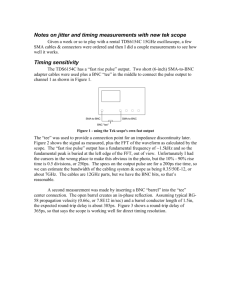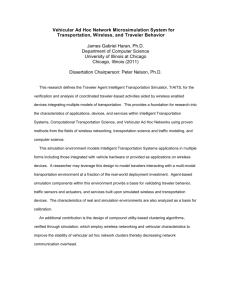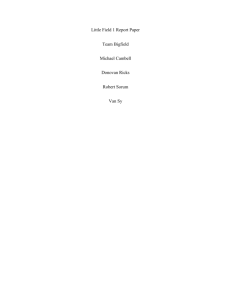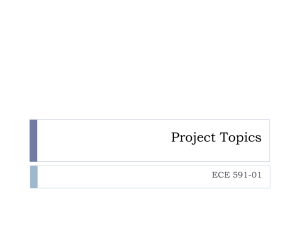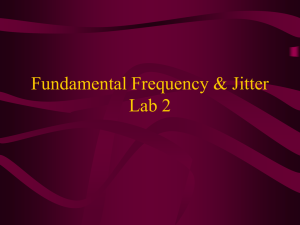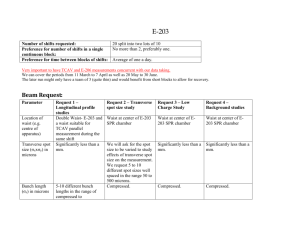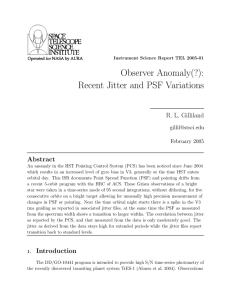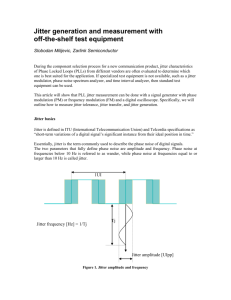edited - MediaLab-NTUA
advertisement
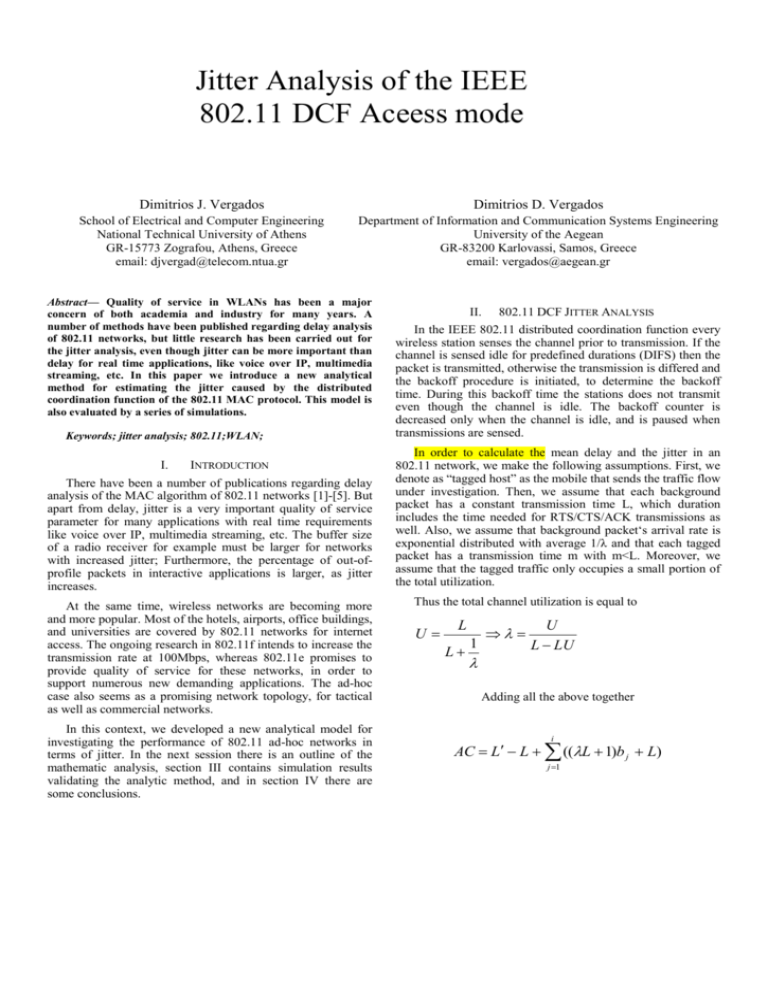
Jitter Analysis of the IEEE 802.11 DCF Aceess mode Dimitrios J. Vergados Dimitrios D. Vergados School of Electrical and Computer Engineering National Technical University of Athens GR-15773 Zografou, Athens, Greece email: djvergad@telecom.ntua.gr Department of Information and Communication Systems Engineering University of the Aegean GR-83200 Karlovassi, Samos, Greece email: vergados@aegean.gr Abstract— Quality of service in WLANs has been a major concern of both academia and industry for many years. A number of methods have been published regarding delay analysis of 802.11 networks, but little research has been carried out for the jitter analysis, even though jitter can be more important than delay for real time applications, like voice over IP, multimedia streaming, etc. In this paper we introduce a new analytical method for estimating the jitter caused by the distributed coordination function of the 802.11 MAC protocol. This model is also evaluated by a series of simulations. Keywords; jitter analysis; 802.11;WLAN; I. INTRODUCTION There have been a number of publications regarding delay analysis of the MAC algorithm of 802.11 networks [1]-[5]. But apart from delay, jitter is a very important quality of service parameter for many applications with real time requirements like voice over IP, multimedia streaming, etc. The buffer size of a radio receiver for example must be larger for networks with increased jitter; Furthermore, the percentage of out-ofprofile packets in interactive applications is larger, as jitter increases. At the same time, wireless networks are becoming more and more popular. Most of the hotels, airports, office buildings, and universities are covered by 802.11 networks for internet access. The ongoing research in 802.11f intends to increase the transmission rate at 100Mbps, whereas 802.11e promises to provide quality of service for these networks, in order to support numerous new demanding applications. The ad-hoc case also seems as a promising network topology, for tactical as well as commercial networks. In this context, we developed a new analytical model for investigating the performance of 802.11 ad-hoc networks in terms of jitter. In the next session there is an outline of the mathematic analysis, section III contains simulation results validating the analytic method, and in section IV there are some conclusions. II. 802.11 DCF JITTER ANALYSIS In the IEEE 802.11 distributed coordination function every wireless station senses the channel prior to transmission. If the channel is sensed idle for predefined durations (DIFS) then the packet is transmitted, otherwise the transmission is differed and the backoff procedure is initiated, to determine the backoff time. During this backoff time the stations does not transmit even though the channel is idle. The backoff counter is decreased only when the channel is idle, and is paused when transmissions are sensed. In order to calculate the mean delay and the jitter in an 802.11 network, we make the following assumptions. First, we denote as “tagged host” as the mobile that sends the traffic flow under investigation. Then, we assume that each background packet has a constant transmission time L, which duration includes the time needed for RTS/CTS/ACK transmissions as well. Also, we assume that background packet‘s arrival rate is exponential distributed with average 1/λ and that each tagged packet has a transmission time m with m<L. Moreover, we assume that the tagged traffic only occupies a small portion of the total utilization. Thus the total channel utilization is equal to U L L 1 U L LU Adding all the above together i AC L L ((L 1)b j L) j 1 In order to calculate the mean delay and the jitter in an 802.11 network, we first calculated the possibility of collision for a given utilization. Then we calculated the delay distribution caused by every retransmission attempt, the possibility of each retransmission, and finally we calculated the mean delay. The jitter was also calculated by considering the probability and delay distribution of each retransmission. A. Netwrok Model The simulated network consisted of fifty wireless stations, all within range of each other. All stations, except one, are generating packets of fixed size at exponentially distributed epochs, whereas the other station was receiving the packets. The details of the simulation are in the following table. This analysis produced the following equations, where CWmin, CWmax, Tslot are parameters of the 802.11 algorithm, k is the number of retransmissions until the CW reaches it’s maximum value, L is the time needed for every transmission (including RTS/CTS/DATA/ACK), m is the time required for transmitting a packet, and p the probability of retransmission (it is calculated from the channel utilization U). The calculated mean delay is m’’ and the jitter is v’’. k TABLE I. i i 1 j 1 i E ( AC ) m 1 p m 2(2 p ) m 2 p m 1 (2 p ) m 1 1 2p p m (m 1 mp) L L ) m 1 p (1 p ) 2 m Um 1 U m The jitter in calculated by the following equations: 3 p k 44 p 4 p k 1 4 p 361 4 p k k 1 p k 1 k kp 121 p 1 p p 2 i k 1 802.11 DCF CWmin 32 CWmax 1024 572 bytes i 1 i 1 CWmax 1 L 2 c3 c4 v L 1Tslot b1 b2 L 1Tslot L2 12 v Uv 20 μsec 2DIFS + PACKET + ACK 0.00245 Exponential 4kbps – 400kbps Traffic Rate (per station) B. Simulation Results The simulation results are plotted in Figure 1 and 2. Figure 1 illustrates the mean delay as a function of the channel utilization, whereas Figure 2 illustrates the jitter as a function of the channel utilizations. In both figures the dashed lines are the simulation results, whereas the continuous lines are the analytical results. As we can see, the simulation results are relatively close to analytic results, even though there not always an exact match. SIMULATIONS In order to validate the above analysis, a number of simulations have been carried out with the Network Simulator 2 [6]. CONCLUTIONS In this paper a new model for jitter analysis of 802.11 networks is presented. The simulation results validated the analytical results. These results clearly show that the DCF access mode can provide low mean delay (very close to the transmission delay) for low utilization, but the mean delay increases rapidly, as the utilization approaches the value of one. On the other hand, the value calculated for the jitter can be considered fairly high (it approaches 0.01 for relatively low utilizations), much higher than the value produced by the PCF access mode [7]. The mathematic analysis as well as the simulation will be presented in detail in the full paper. V. III. 572 * 8 / 2*108 = 0.002288 sec Tslot IV. k i c3 1 p p i 1 2 CWmin j 2 L i 1 1 c4 50 Traffic Generator (L 1) * T * (2W min 1 b2 2 CWmax 2 Number of wireless stations Transmission Duration (m) i k 1 j 1 b1 2 CWmin Value Packetsize (with headers) a2 2 CWmax 1 1 p p i 1 2 w max 1 Attribute Mac protocol a1 2 CWmin 1 2 j 1 1 p p i 1 SIMULATION PARAMETERS [1] [2] [3] REFERENSES IEEE std. 802.11, “Wireless LAN Medium Access Control (MAC) and Physical Layer (PHY) Specifications“, 1999. Giuseppe Bianchi, "Performance analysis of the IEEE 802.11 distributed coordination function", IEEE Journal on Selected Areas in Communications, no. 3, March 2000 pp. 535-547 Andras Veres, Andrew T. Campbell, Michael Barry, Li-Hsiang Sun, "Supporting service differentiation in wireless packet networks using distributed control", IEEE Journal on Selected Areas in Communications, no. 10, October 2001 pp. 2081-2093 [4] [5] [6] Stefan Mangold, Sunghyun Choi, Guido R. Hiertz, Ole Klein, Bernhard Walke, "Analysis of IEEE 802.11e for QoS Support in Wireless LANs", IEEE Wireless Communications, no. 6, December 2003 Wasan Pattara-Atikom, Prashant Krishnamurthy, Sujata Banerjee, “Distributed mechanisms for quality of service in wireless LANs”, vol. 10, no. 3, Jun 2003, pp. 26 – 34 The Network Simulator 2, www.isi.edu/nsnam/ns [7] Dimitrios J. Vergados, and Dimitrios D. Vergados, "Synchronization of multiple access points in the IEEE 802.11 Point coordination Function", IEEE 60th Vehicular Technology Conference 2004-Fall "Wireless Technologies for Global Security" (2004 VTC – Fall VTS), Los Angeles, CA, USA 2004 0.04 0.04 0.03 0.03 0.02 0.02 0.01 0.01 0.2 0.4 0.6 0.8 Figure 1. Mean Delay as a function of channel utilization 1 0.2 0.4 0.6 0.8 Figure 2. Jitter as a function of channel utilization Figure 3. 1




